|
The story of
Lancaster KB-976 is an
interesting one since it was
both the beginning and, sadly,
the end of the first real flying
aviation museum in Canada.
I was a
pilot in the RCAF over a 10 year
period, Regular and Reserve,
extending from 1954 – 1964.
During that time I witnessed,
and actually participated in the
departure of several famous
types from Canada’s inventory. I
was last to check out on the
P-51 Mustang with 403 City of
Calgary Squadron RCAF and last
to fly the Hawker Sea Fury. And
then, I was the last to pilot
the Avro Lancaster in RCAF
service, but that is getting
ahead of the story.
The museum
story started when I was 25 and
ended when I was 29.
As the
Mustangs were retired from the
RCAF I obtained a contract to
fly something like 70 surplus
aircraft to their new owners in
the States. Milt Harradence, an
ex-403 Squadron pilot would
accompany me. While visiting the
old RCAF Station Macleod, in
southern Alberta to inspect
Mustangs stored there, we saw a
large number of Lancasters being
prepared for the melting pot. I
decided to save one as a
memorial to the many who trained
under the British Commonwealth
Air Training Plan, during World
War Two. Nearly 140,000 students
graduated from this program.
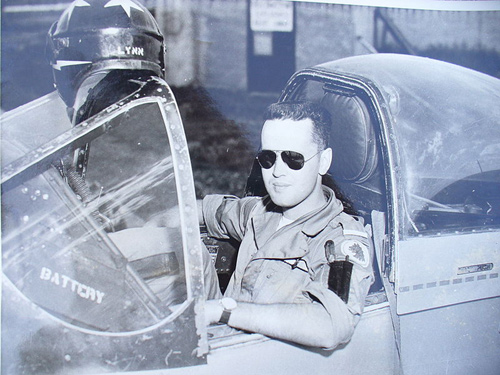
F/O Lynn
Garrison, 1958 aged 20
After some
negotiation, I purchased
Lancaster FM-136 without
engines. Four Merlins for the
ferry flight to Calgary were
borrowed from the RCAF and
FM-136 was serviced by
volunteers from local 886
International Association of
Machinists, working with
Canadian Pacific Airlines
Repair. It would be mounted on a
pedestal at McCall Field,
Calgary’s international airport
during the spring of 1962. (In
1993 I would return to Calgary
to block its sale, by the City
of Calgary, to the
Confederate Air Force. As a
result of this, it remains on
display there.)
Lancaster
FM-136 in February, 1962
immediately after being painted
for memorial.
As a result of
the Mustang ferry project, James
DeFuria, the American purchaser,
gave Milt Harradence, and me, a
pair of Mustangs that were
registered as CF-LOR and CF-LOQ.
Milt flew his for a while until
he just had to have a
Dehavilland Vampire. I found one
for him and he sold the Mustang
which now flies as Checkertail
Clan, N-1451D.
At this
point I decided to collect
aircraft for a museum and
started the Alberta Aviation
Museum with a box of letterhead
and portable electric
typewriter. There were
hundreds and hundreds of War Two
aircraft scattered across the
prairies, sitting in farmyards
since being towed from local
airfields by purchasers
interested in gasoline in their
tanks and other small things.
The basic aircraft remained.
Farmers were
pleased to help, and made their
surplus equipment available to
me. A local trucking company
supplied a vehicle to haul the
display items to the Shell oil
pipe yard in north eastern
Calgary. Shell was kind enough
to let me store my aircraft
there and use their rail siding.
In no time I
had 2 Mustangs, Bollinbrokes
(3), a Lysander, Fleet Finch,
Tiger Moth, Fairey Battle (2),
Avro Ansons Mark 11 and V,
Stinson Reliant, Fairchild
Cornell, Airspeed Oxford, Cessna
Crane, North American B-25,
Nordyn Norseman, Harvard, Yale,
2 Hawker Hurricanes, all
accumulated locally plus a
Supermarine Spitfire AR-614 from
the United Kingdom, an F4U-7
Corsair 133693 from France, a
B-24 (HE-771) Liberator from
India, a Dehavilland Mosquito
(RS700 – CF-HMS) from Spartan
Air Services, a TBM Avenger,
Seafire, and a few aircraft
purchased from the Canadian
government. A T-33 Silver Star
serial 21001, the first acquired
by the RCAF with 210 hours on
the airframe: (My son Tony, a
lifetime later, would purchase
the last RCAF T-33 133648) a
CF-100, Sikorsky S-51, a Vought
Kingfisher, salvaged from a
British Columbia mountain top,
and - unfortunately – two
F-86 Canadair Sabers in Golden
Hawk colours. In all, I
would have 57 aircraft, plus a
lot of bits and pieces, plus
others promised.
My then wife,
Evelyn, did without most things
a young woman would expect from
life, in order to find the funds
needed to acquire another piece
of history. She should be
remembered for this.
In 1963 I
founded the Calgary
International Air Show as an
annual event to fund and
publicize the project. It was to
be held each July. As we
were working up to the 1964
show, and final exams at
university, I was offered a
Lancaster for $1,500.00. There
was a scramble for money, and
$1,500.00 was real money in ’64,
especially to someone in school
with a wife and family. I had
just purchased a new house for
$12,200.00 and, in 2013, it is
worth something close to
$400,000.00 on today’s market.
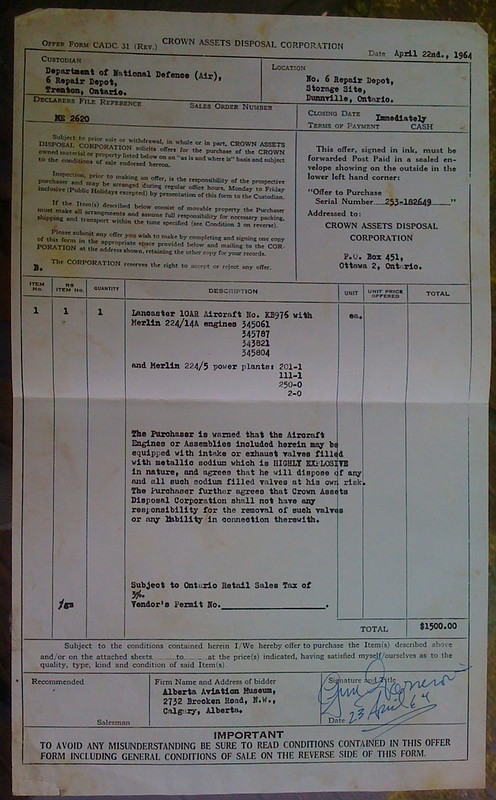
Original
bill of sale, courtesy of Lynn
Garrison
A few weeks
later Lancaster KB-976 was flown
into Calgary and parked in front
of 403 Squadron’s hangar. The
crew climbed out and left
everything but their headsets in
place, handing over the log
books before taking another
flight back to 408 Squadron.
The aircraft
arrived sometime in April, 1964
as we were planning that year’s
air show. As soon as I saw
KB-976 I decided I would fly it,
one last time, but didn’t tell
anyone. I would walk around the
aircraft. I would climb in the
starboard rear door, immediately
in front of the horizontal
stabilizer, and make my way up
to the cockpit, climbing over
the massive main spar, en route.
Without any Pilot Handling
Notes, I managed to start the
engines using experience from
the Mustang. Sitting there, I
would listen to the rumbling of
4 Merlins and watch reactions on
various system indicators.
I gradually
became confident in my plan.
Others
knew of my record, with other
types, but suggested the Lanc
was something else. I should
let an experienced Lancaster
captain fly the aircraft, with
me as copilot. At the time 403
Squadron had an ex-Lancaster
pilot with something like 1900
hours on type. Bill agreed to
show me the ropes and arrived
one Saturday morning for the
first lesson. We did a quick
external and then made our way
to the cockpit. Several
squadron mechanics stood by to
pull the chocks since Bill was
going to show me how to
taxi. He looked around,
as though expecting something.
Unsure of how to start the
engines, I got them going for
him. (Bill had always enjoyed
the support of a flight
engineer who handled things.)
After a few minutes my friend
waved the chocks away.
I stopped
this, pointing at the Brake Air
Pressure Accumulator gage which
was sitting near zero, while
those that indicated the
individual brake pressures sat
at a couple of hundred pounds.
Unlike
American aircraft, many British
types had air brakes with a
squeeze handle on the control
wheel. Pressure to left and
right brakes was controlled by
the rudder pedals with equal
pressure, to both, with the
pedals centralized.
A few more
minutes passed.
Impatient,
Bill again waved the chocks
away. I pointed to the
accumulator pressure, still near
zero, and he snorted something
to the effect that he knew what
he was doing.
Chocks away!
Bill opened
up the 4 Merlins, to overcome
inertia. The 4 spluttering
engines surged to a cutting
roar! The bomber moved forward,
accelerating. Bill reduced the
throttles, engines spluttering
to idle, and applied right
rudder, squeezing the brake
handle to swing us down the
taxiway.
With a
decreasing hissss, what little
pressure had built up was
rapidly depleted, having little
effect on the aircraft heading.
Throttles yanked back against
their stops, the Lancaster
rolled sedately forward to
become wedged in the poplar
trees surrounding the squadron
hangar.
Mixtures
into Idle-Cut-Off and props spun
into silence.
Bill climbed
out and departed. “He had an
appointment to take his wife
shopping.” I was left to hook a
chain around the tail wheel
strut and tow the Lanc back to
its starting point.
I was now
committed to a do-it-yourself
approach. I would captain the
aircraft. We needed a
Department of Transport approval
for one flight. The Mustang
ferry project had seen us have
the individual aircraft
serviced, and then signed out by
a qualified engineer. I would
use this procedure.
It was so
simple.
Wrong!
The
Lancaster type had once received
a full Certificate of
Airworthiness. In order to be
flown for a single flight, it
would have to go through the
entire process. By this time the
DOT knew what was on my mind and
threw this roadblock in my path,
sure that it could not be
overcome, without many thousands
of dollars in mechanical work.
We had
invited Paul Hellyer, Canada’s
Minister of National Defence, as
our Guest of Honor for the 1964
Calgary International Air Show.
He was a close friend of Art
Smith, a War Two Lancaster
pilot, DFC, and recent
Member of Parliament for
Calgary, South. Art was on my
air show committee. I asked Art,
and Art asked Paul Hellyer, and
the Minister said we could fly
it in RCAF colors, as an RCAF
aircraft for one last flight,
sending a letter to this effect.
I forwarded
the letter to our DOT office in
Edmonton with the question as to
qualification for the pilot.
Dick Beatty, the Regional
Director of Air Services phoned
me to say…”Multi-Engine
Commercial so you can fly it…”
He had known all along what my
plan was.
Brian B.
McKay had helped find the cash,
so he said he would go along.
Ralph Langemann decided he would
go, as did Joe McGolrick. Jimmy
Sutherland was proposed by Tony
McCarten, whose company had
serviced the Lanc for me,
since Jimmy had been a Lancaster
Flight engineer during World War
Two. People thought I was crazy
but the insanity must be found
in my crew, since they knew I
had never flown a Lancaster, and
had to carry me out to the
aircraft, due to my broken
ankle.
At the last
minute, someone had given me a
four page Xeroxed Lancaster
Check List so we buckled in
and followed the program,
searching for, and
discovering, new things, as we
went.
We were
ready to fire up!
We started
the starboard outer, then the
starboard inner, turning our
attention to the port side and
the other two, we lost the
starboard outer, and had
this pointed out by Brian
McKay. Got it restarted and we
were finally on the way with
McKay standing behind me,
holding a ten channel
Skycrafters transceiver on his
head, its headset over my
ears. We had assumed
that we could get the aircraft
radio to operate, but
couldn’t.
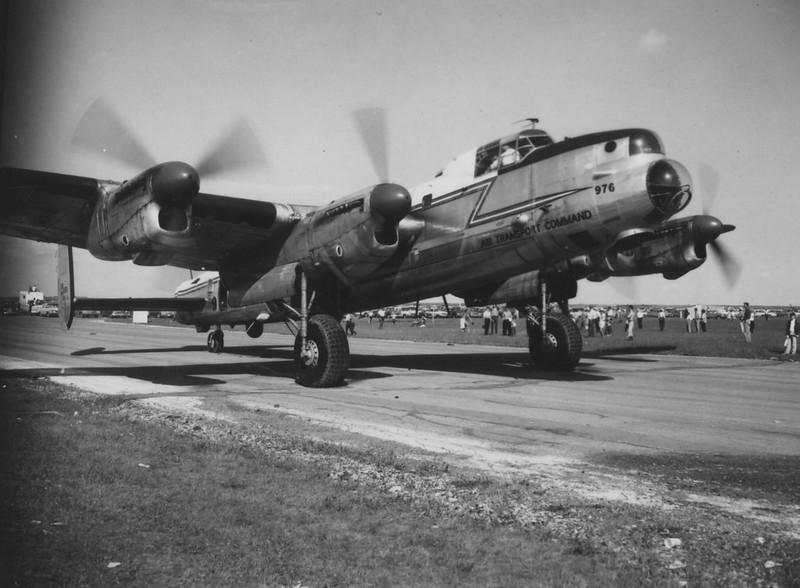 Photograph
courtesy of Ken Hyde
Photograph
courtesy of Ken Hyde
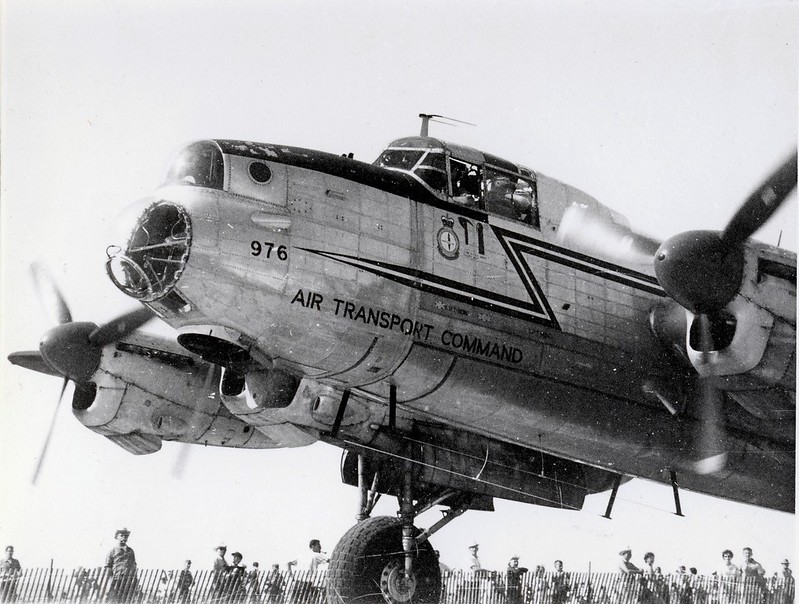
KB976
at start up. Garrison is just
visible in the cockpit window.
With my broken
ankle , I was relieved to have
a hand-operated brake system.
Cleared to
Runway 34, a short distance
from where we were parked, our
run-up was soon complete. I
moved onto the runway to
receive both a green light and
radio call clearing us for
take-off. The controllers
didn’t have much faith in the
tiny Skycrafters transceiver.
As part of
my research, I had talked with
Ben Budgeon who flew North
Stars, with the same engines.
He told me to lead with the
right throttles to overcome
torque, opposite to that of
the Mustangs.
Shoving
throttles forward, four
Merlins took over and launched
us down the runway, tail
rising as our airspeed built
towards lift off. Ralph
Langemann placed his hand over
mine, taking control of the
quadrant as we skipped into
the air. With a nonchalant nod
to Jimmy Sutherland I shouted
“Gear Up!” and he
reacted.
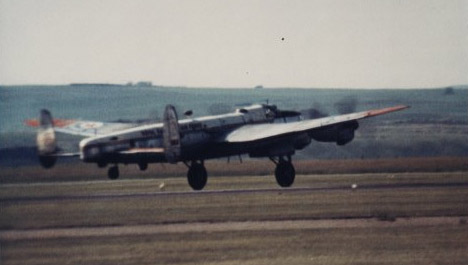
The take off, 4th July 1964
As the
undercarriage started to
cycle, there was a gigantic,
explosive bang. The cockpit
filled with dust and noise! We
were slewing to one side. I
thought we had lost an engine!
I don’t
know what the others thought.
Not a good
first flight!
An
explosion and engine failure
on lift of is not an
optimistic start.
The Lanc
straightened out.
The dust
cleared.
The four
Merlins were functioning.
What had
happened?
A lower hatch,
that previously housed the
radar antenna had blown up
into the nose compartment,
where Joe McGoldrick was
perched. The asymmetric
reaction was caused by the
main gear coming up, one at a
time.
No problem!
We were on
our way!
And so, Ralph
Langemann and I flew Lancaster
KB-976 around and across
McCall Field, at varying
heights and speeds,
accompanied by my Mustang and
a P-40 owned by Bob Warden.
During one pass we ran
directly over FM-136 on its
pedestal, creating a classic
shot of KB-976 and the
Lancaster Memorial.
 Photo
courtesy of Lynn Garrison
Photo
courtesy of Lynn Garrison
FM-136 is now
a permanent display in
Calgary’s museum, without even
a mention of my name or
involvement. That’s life. At
least the aircraft was saved
for future generations.
We entered
the downwind leg, of our
approach, and Jimmy Sutherland
dropped the undercarriage. I
compensated with a touch of
throttle turning onto a 90
degree base leg and then onto
final, dropping flap as we
lined up on 34. “Gear Down”
and Jimmy Sutherland went into
action again. Some trim to
overcome control pressures on
the wheel.
Over the
fence. Throttle back. Hold
off, waiting for the big
bounce I had been warned
about.
Squeak…squeak… a greaser, and
we were rolling straight down
the runway, slowing at the
first turn off for the short
taxi back to our parking
place.
Braking to
a stop, crewmen placed metal
chocks in front of the Lanc’s
big main wheels.
Sutherland pulled four
mixtures into Idle Cut Off.
Our historic flight was over
as silver props spun into
silence.
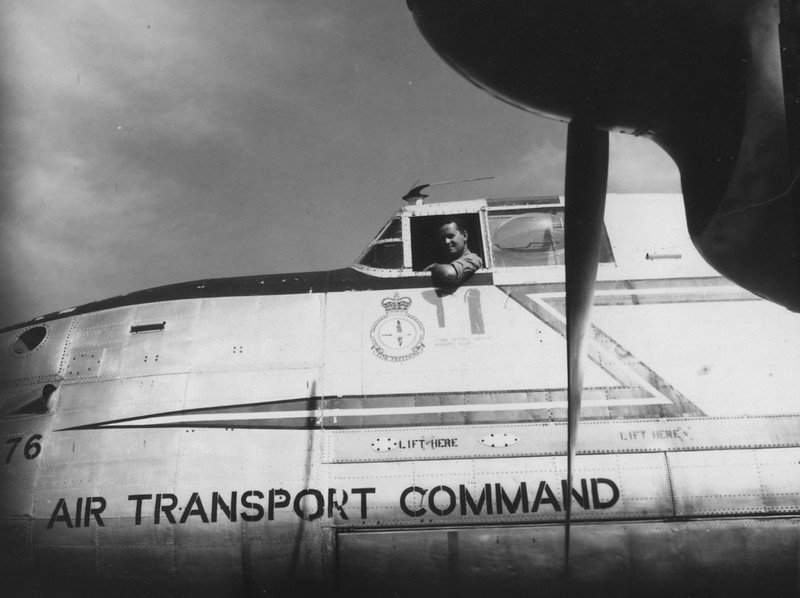 Photograph
courtesy of Ken Hyde
Photograph
courtesy of Ken Hyde
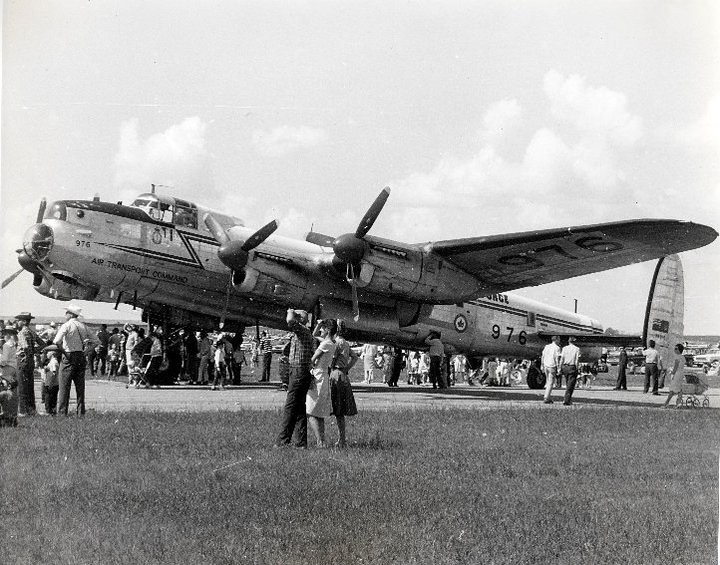
The RCAF
Harvard demonstration team was
sitting there watching.
A Wing Commander in
charge, who was once commander
of the Lancaster Operational
Training Unit, murmured,
on seeing the landing…”Shows
what good training will do…”
One of his pilots said..
”Believe it or not, that was
their first flight.” The
Wing Commander wouldn’t accept
the fact until Art Smith
commented that evening, as I
was carried to the head table
and placed on a chair.
A week
later, when the swelling had
decreased, I had a DOT
medical, for renewal of
my Commercial License. Same
day I got a cast on my broken
ankle and would fly Harvards
on hail suppression for the
university holidays. Trying to
brake a Harvard, with a cast,
was exciting, but that’s
another story.
In April,
1964 the museum project took
on an official foundation. The
Air Museum of Canada was
incorporated as an Alberta
non-profit with 100 voting
shares. I held 98, my wife
held one and my mother held
the other. I named a few
friends to the non-voting
Board of Governors, a move I
would regret – in 1966 - when
these friends staged a palace
coup after Milt Harradence
attacked me.
Another
year passed and we were again
focused on the air show. This
time it would be in support of
The Air Museum of Canada and
would feature an RAF Vulcan
from 617 Squadron, plus a lot
of other aircraft. KB-976 was
a static display.
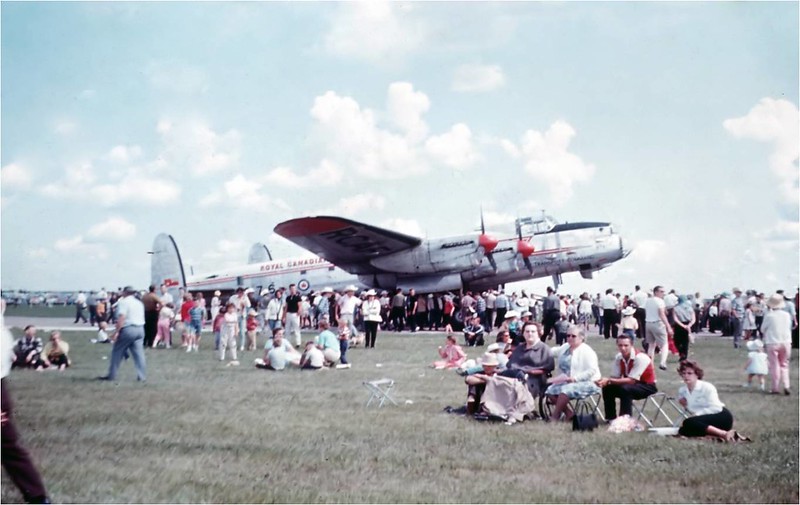
Photograph
provided by courtesy of Dick
Richardson
KB976
in RCAF colours just after
retirement as an airshow exhibit.
Over the past 12
months I had acquired a CF-100,
T-33, Sikorsky S-51 and now
scrambled to come up with cash
required to purchase a pair of
freshly overhauled Canadair F-86
Sabres in Golden Hawk colors.
I borrowed
$1500.00 and gave a Lien against
the Lancaster’s Title.
Milt
Harradence saw the Sabers and
had to have one. I explained
that we had acquired them under
a ‘mutilation agreement’
requiring cut main spars, if we
disposed of them. He just
couldn’t take this as an
adequate answer and continued to
press. After all, we had flown
together, he was my best friend
and had stood as my Best Man
when I was married.
Yet another
year passed, and the 1966 show
was sure to be a winner. The
Americans had promised 10
different acts, including the
USAF Thunderbird aerobatic team.
Milt was
still pressuring and asked if he
could have one, provided he got
government approval. I agreed
and said this must be in
writing. Charlie Drury, the
Minister of Commerce soon called
to say I could let Milt have a
Sabre. I asked for confirmation
in writing and – obviously – the
minister discovered what was
involved, and never wrote the
letter.
Milt
insisted that I sign the
aircraft over to him, in trade
for two Dehavilland Vampires.
I refused,
saying I had an agreement with
the government and had explained
this to him at the very start.
He offered to defend me in an
action that might result. Now,
Milt was one of the top trial
attorneys in Canada, and had
exceptional political
connections. I countered with a
comment to the effect that there
would probably be no action, but
the government would never sell
me another display.
The fat was
in the fire!
Milt sued
me! Calgary’s leading attorney
against a poor university
student, who happened, up to
that point, to be his best
friend! Unfortunately, Milt was
a person who would not be
thwarted, no matter what, by
friends, family – anyone!!
He also set
out to derail my application for
the annual air show by forming
The Calgary City Police Flying
Club with one member, a tame
sergeant. He tried to get
approval for his show, on our
dates.
He went to
the guy who had the Lien on the
Lancaster and bought the note.
He then demanded payment –
immediately!! Ernie Johnson
stepped in and took over the
Lien and the war went on.
I can
remember the last appearance at
the City of Calgary Aviation
Commission as Milt fought for
control. It was a frustrating
situation that saw me finally
react, with the comment: “You
must understand that the
displays are committed to the
Air Museum of Canada, and not
the City of Calgary…” This
drew a raucous chorus of
laughter, from the committee
members, and the meeting was
adjourned for another week.
I walked out
of the City Hall and stood on
its steps as my supporters.
All wished me the best of
luck, but they couldn’t go
forward to Red Deer. We shook
hands and I got in my car for
the drive to RCAF Station Namao,
outside Edmonton, Alberta, for
an agreement to stage my
American acts from their
facility. I then drove to Red
Deer for final talks with
aviation enthusiasts there,
having started talks two weeks
before. We agreed to transfer
the air show to Red Deer.
Calgary never had another air
show.
I had
something like 3 weeks to build
an organization to support the
project. Even as I was doing
this, Milt Harradence flew to
Nellis Air Force Base in an
attempt to have the THUNDERBIRDs
cancel their show. Team leader,
Lieutenant Colonel Ralph
Maglione refused and, when they
flew over Calgary, on their way
to Edmonton, they circled the
city with their smoke on as a
demonstration of support for me.
The 1966 team members have
remained friends, over the
years, and Mag retired as a
Major General.
The show was
a success.
The Canadian
government finally agree to let
Milt have the Sabre and this was
registered as CF-AMH
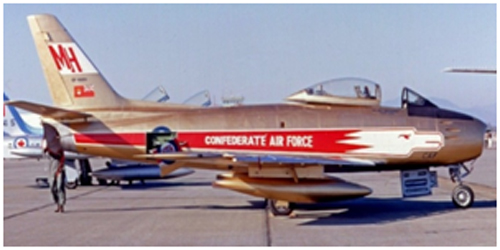 Photo
credit Harradence family.
About this
time I had some major offers
from the film business and
travelled to California for
projects, hoping to generate
funds for the first Canadian
flying museum.
I was soon
immersed in the Warbird
community, which wasn’t too
big in 1966. Milt and I had a
relationship with founders of
the Confederate Air Force –
Connie Edwards, Lefty
Gardiner, and Lloyd Nolan.
Milt was a Colonel but I never
joined. However, at my
suggestion, they started to
paint CAF in wartime colors,
replacing the overall white
scheme with red and blue trim.
I
sponsored the 1966 Los Angeles
International Air Show, at
Brackett Field, adjacent to
the LA County Fairgrounds with
over 50,000 attending the two
day production. Chuck
Lyford did an F8F Bearcat
routine that started with
short take-off and climbing
roll as wheels retracted.
Spectacular!
Over the
coming weeks, we all flew at a
number of shows, talking about
World War Two aircraft in our
spare time. The people from
Seattle were fascinated by my
tales of stored aircraft and
moved to obtain funds to
service and fly a few of my
items as first examples of a
flying museum. Since the
Lancaster, Vampire and
F-86 were already nearly
flyable it was decided to
start with these. Lyford and
Clarke had exceptional
contacts in the upper levels
of Seattle’s aviation, and
financial community. One of
Boeing’s hangars at Paine
Field was offered.
The
Lancaster could serve as a
cornerstone for what could
come. We would service it,
paint it and do the air show
circuit.
Chuck
Lyford, (P-51), Gil Macy,
(P-40) John Church, (F8F) Joe
Clarke, Jim Larsen, (one of
the great aviation
photographers, and
aeronautical engineers), and I
flew off to Calgary to on a
recce mission, to look at
KB-976 and see how many weeks
it would take to get the
Lancaster into shape. It had
been sitting there since July,
1964. We would then take it to
Paine Field, in Washington
State, where it would be
painted and readied for the
air show circuit.
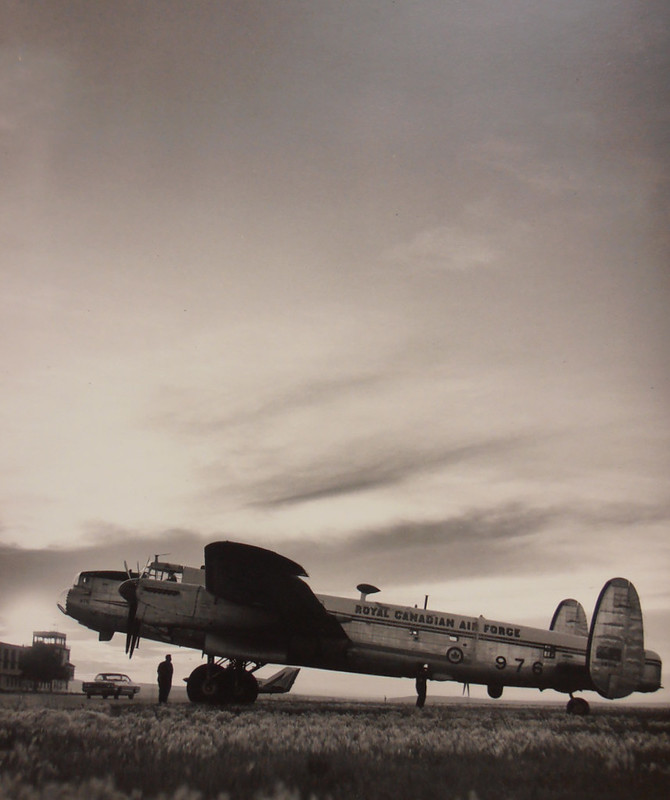
Picture
by Jim Larsen.
May/June
1967 Calgary, McCall
Field. The
aircraft had been in
this spot since 1964.
Chuck Lyford in
the cockpit, John Church
standing under the
nose,and Gil Macy
standing under the rear
of the aircraft.
I had
tried to reach Ernie Johnson
by phone, prior to boarding
the flight, but he was
unavailable. This was a
normal condition with Ernie.
As one of Canada’s top
eye-ear-nose specialists, he
was always in great demand.
And so we
arrived in Calgary. I left
them at the terminal
building with instructions
not to go near Lancaster
KB-976 until I made
contact with Ernie to give
him his $1500.00 and clear
the Lien.
Since
my wife and family were
still living in our home,
I caught a ride to the
house to pick up my car
and call Ernie. He was
still not available.
Nothing unusual.
This was before the time
of cell phones, so I
headed back to the
terminal at McCall Field.
When I arrived, some
friends said my team had
gone across the field to
look at the Lancaster.
I
discovered them surrounded
by police. Someone thought
they were trying to steal
the Lancaster. When I
arrived, we were all taken
to the police
headquarters, in downtown
Calgary. Ernie Johnson
appeared and was
embarrassed at the
situation.
When we
arrived at the station, I
moved to make a phone call
to my wife, alerting her to
the situation, so she could
make a few calls to
strategic people.
At this
point, Detective Sergeant
Simmonds lunged across the
room, punching me in the
face with three quick blows,
yelling…”When you’re under
arrest you don’t make
calls!”
Another
policeman said…”He isn’t
under arrest!”
Simmonds
replied, “Well, he is now!”
About
this time, Milt Harradence
walked past the door and
looked it, spotting Clarke,
Lyford, Church, and Macy,
instantly recognizing them.
He grabbed an Inspector and
told him who they had and
they had better spring
everyone or there would be
some serious repercussions.
Joe Clarke’s father was
chairman of the American
Petroleum Association.
Lyford was married to Mary
Reed of the Simpson-Reed
Lumber group. Church’s
family headed a major pickle
corporation and Gil Macy’s
partner was Founder and
Chairman of the Flying Tiger
Line.
Everyone
else was released and, since
I had been arrested, I was
tossed in a cell overnight,
to wait for a Magistrate. I
can remember lying there,
passing in and out of
consciousness, not sure that
I would see the morning. No
one would call a doctor.
At 9
A.M. a Magistrate arrived
and the charges were
dismissed. My wife picked me
up and drove to the hospital
where I was admitted. Three
weeks later I was still in a
condition that precluded
flying. I had suffered some
broken bones and a
concussion.
During
those days, I had decided to
leave Calgary for good. I
visited Eric Harvey, the
founder of Calgary’s Glenbow
Foundation, one of the
world’s leading museum
groups. Harvey was the
richest man in Canada and
had been my father’s friend
since they served in World
War One. Harvey had been
with the Royal Flying Corps
and had already stated his
interest in supporting my
museum effort. He had
recently purchased the
Sikorsky S-51 helicopter for
me and was committed to
building a home for the
collection.
I
offered Harvey the
collection, free of
charge. He declined
with the comment. “The
aviation museum is a
personality based
organization. Without you,
it will fail.” At the
time I did not appreciate
the truth of this but
subsequent events proved him
right.
And so,
I left the collection stored
in Shell Oil’s pipe yard,
packed a U-Haul trailer with
some possessions, loaded my
family and set out for
California, to play a part
in the aviation and film
industry. I already owned
the collection of World War
One replicas accumulated, in
Ireland, for 20th
Century Fox’s The Blue Max.
I had my personal F4U-7
Corsair – THE BLUE MAX for
air show work, in the
States.
Lynn
Garrison’s Vought F4U-7
Corsair 133693
BLUE
MAX
Obtained
from French Navy, registered
N693M
Lynn
Garrison’s collection of
film aircraft Weston
Aerodrome
Ireland,
during filming 1969. Blue
Max Aviation, Ltd
My
Canadian associates found
there was more to the project
than being members of a
non-voting board of governors.
One by one they dropped away.
One
remained. Peter D. Norman took
over without checking the
documentation. Although the
Air Museum of Canada had been
incorporated in April, 1964,
none of the aircraft had been
transferred into the company
name. This small problem did
not stop this guy as he
disposed of my Supermarine
Spitfire AR-614, a Hawker
Hurricane, that was smuggled
out of Canada, by Rem Walker,
to become G-HURI, and a lot of
other items.
Even as
they tried to get KB-976 a
Certificate of Airworthiness,
under registration CF-AMD, so
it could be flown for
exhibition, (CF-AMC was on our
1909 Curtis Flyer), Ernie
Johnson’s interest in the
aviation museum faltered when
someone offered him $150,000
for Lancaster KB-976 and that
was really the final straw in
breaking down any possibility
of Calgary having a meaningful
aviation display. Since he had
a Lien for $1500.00 against it
he felt he also had the right
to sell the aircraft, and he
did. So much for team
cohesion, and all that
emotional garbage.
I never
sold a single item, although I
did give pieces away, to help
others. One set of Hurricane
wings made the Hurricane
project, by Neil Rose in
Vancouver, Washington, a
success. And I donated
my Vought OS2U Kingfisher to
the North Carolina Battleship
Commission. It now has a
place of honour on the
USS North Carolina.
Eight or nine
of my original collection
remain in Calgary.
My
Mosquito, and one of my
Hurricanes are now being
rebuilt at the Bomber Command
Museum in Nanton, Alberta. The
City of Calgary had tried to
sell them to someone in the UK
for several million, but were
stopped by a new generation of
enthusiasts. Supermarine
Spitfire VB AR-614 is now a
beautiful display at Paul
Allen’s Seattle-based aviation
museum. My Vought
Kingfisher is now displayed on
the North Carolina Battleship
Commission, having been
rebuilt by friends at LTV
Aerospace in Grand Prairie,
Texas.
My son
Patrick and I still have three
aircraft from the film
collection, a Fokker Triplane
and 2 SE5s. Well, actually,
the 2 SE5s are his alone.
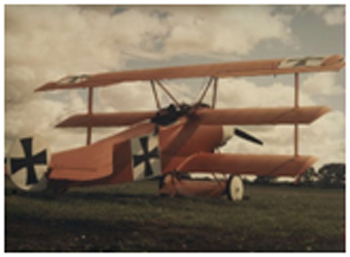
I didn’t
return to Canada until the
June 1986 death of Rod, Milt
Harradence’s son, in a plane
crash. I had baby-sat him as a
young child and returned after
the funeral, with my sons Tony
and Patrick, to see Milt and
his family. It was sad that we
had lost all of those years.
I moved on
to other things and presently
head the Haitian Children’s
Fund, a team that has created
the Satellite School System.
It has a studio and uplink
system that will bounce
classes off an Intelsat
satellite to any point in the
country. The lessons will be
collected with a dish antenna,
receiver and wide screen TV,
powered by solar panels, an
inverter and batteries.
We might
raise the literacy rate by a
few points in the first 12
months.
Most of
the others have passed on,
leaving Ralph Langemann and me
as the last men standing,
after a wild and lengthy
barroom fight.
Perhaps
they did me, and the Haitian
kids, a favor by destroying my
hopes of creating and heading
a flying aviation museum.
Of course,
Lancaster KB-976 flew across
the Atlantic to join the
museum world there, finally
bouncing back to Kermit
Weeks’ museum in Orlando,
Florida, but those are other
elements of KB-976’s ongoing
saga.
Lynn Garrison, July 2013
|